
浏览:次
Dr. Xinxin Cao, Associate Professor Jiaxin Sun and Professor Fulong Ning from our laboratory published a paper entitled Numerical analysis on gas production performance by using a multilateral well system at the first offshore hydrate production test site in the Shenhu Area in the journal energy.
1、Abstract
Natural Gas Hydrate (NGH) is a promising alternative source of energy, which is widely distributed in the seafloor and continental permafrost. Recently, how to economically exploit natural gas from hydrate reservoirs has become a hot topic all over the world. Since the successful production test in the Shenhu area of the South China Sea (SCS) in 2017 and 2020, the progress of industrialization development has been further accelerated. However, the current production performance of existing pilot wells is still far from the commercial development standard. Previous studies have shown that the South China Sea hydrate and underlying free gas reservoirs have the characteristics of low permeability and heterogeneous distribution. Although the two wellbore depressurization developments organized successively have been successful, the traditional vertical well development is limited by the hydrate reservoir. Due to thickness constraints and low transfer efficiency of reservoir pressure drop, it is difficult to achieve an order of magnitude breakthrough. Although horizontal wells can greatly expand the drainage area of reservoirs, they are limited by high drilling and completion costs and technical difficulties. Therefore, in order to make full use of the respective advantages of vertical wells and horizontal wells, and avoid the technical difficulties caused by the construction of ultra-long horizontal wells in shallow weakly consolidated formations, the development mode of horizontal multi-branch wells has obvious advantages, and is suitable for heterogeneous wells. It is a well type with great potential for production enhancement (Fig. 1).

Fig. 1 Schematic diagram of multi-branch well system production for the first hydrate test production reservoir in Shenhu sea area
However, there are few reports on the optimization and analysis of multi-lateral well joint production layout scheme. Based on this, we established a site-scale three-dimensional numerical model, adopted different multi-lateral well layout schemes, and carried out detailed gas production performance numerical simulation and deployment strategy optimization analysis for the first hydrate test production reservoir in the South China Sea. This study provides a new idea for the study of production enhancement and efficiency enhancement of silty hydrate reservoirs in the South China Sea (the upper part is the hydrate layer, and the lower part is the three-phase layer and free gas layer).
2、Methods
The simulations in this study are implemented by pT + H V1.0, a parallel version of TOUGH + HYDRATE. TOUGH + HYDRATE can model the nonisothermal gas release, phase behavior, fluid flow and heat exchange in complex geological media using equilibrium or kinetic model of hydrate formation and dissociation. Based on the data obtained, a reservoir-scale 3D model is built according to the actual geological parameters at the site SHSC-4 (Fig. 2). The size of cuboid domain is adopted as 200 m × 200 m × 138 m in the x- , y-, and z-direction. The top and bottom boundaries are assumed to be Dirichlet boundaries and no external source of fluid or heat can cross the lateral boundaries of the simulated domain after considering the symmetric deployment of multilateral wells. In addition, the branch well deployment strategy adopts the idea of orthogonal test design, and an orthogonal table with four factors and three levels is established for the optimization analysis of the branch well deployment structure.

Fig. 2 Model size and mesh division
3、Simulation results
(1) Prediction of production behavior of lateral wells under different layout schemes
Fig. 3 describes the gas production simulation prediction results of lateral wells under different layout schemes. When the multilateral well is deployed at the interface between the three-phase layer and the free gas layer, its production efficiency is relatively high, and this deployment method is more conducive to the efficient combined production of the upper hydrate and the lower free gas. Different layout schemes of dual-branch wells may have the same impact on hydrate dissociation. The simulation found that in a one-year production cycle, the gas production rate can reach up to 4.37×106 m3, and the water production rate remains low, which shows that the reasonable layout of dual-branch wells The well has good production potential. In addition, with the increase of the number of branch wells, the amount of hydrate decomposition increases significantly, but the total gas recovery rate does not show an order of magnitude increase, which may be related to the interference between wells.
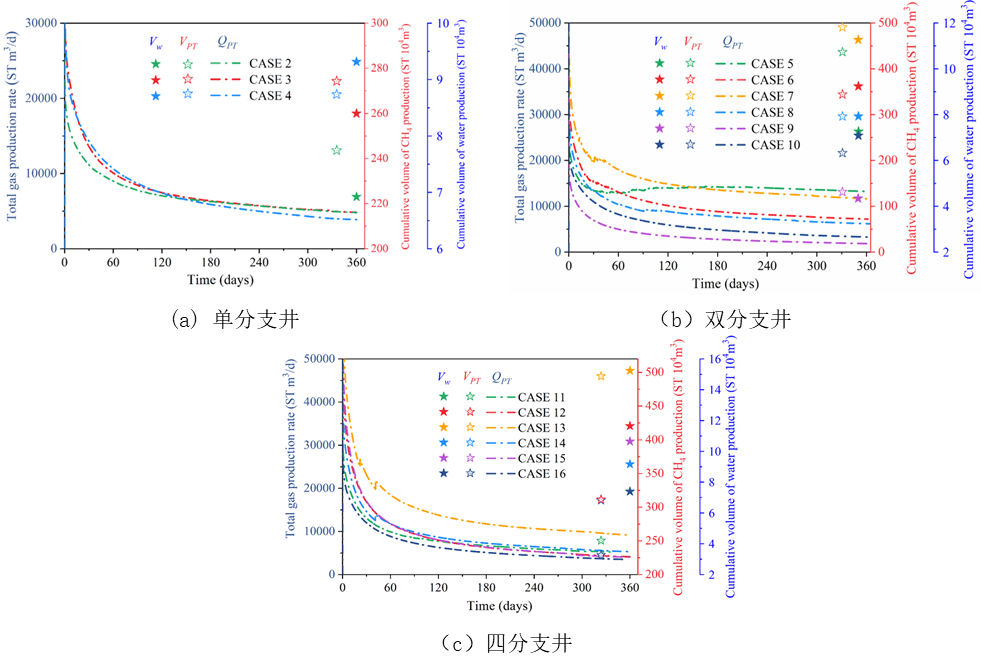
Fig. 3 Prediction results of lateral well production behavior under different schemes
(2) Research on the optimal deployment position of branch wells
This paper adopts the method of range analysis to determine the sensitivity of different geometric factors: phase angle, length, spacing, and position by sorting. As shown in Fig. 4(a), in terms of the total gas production index, the importance of different geometric layout parameters of the branched well is ranked as follows: deployment position>spacing>phase angle>length within a one-year production cycle. Also based on the comprehensive balance method, the optimal geometric deployment scheme of the two branch wells within a one-year production cycle can be obtained: the branch wells are deployed in the three-phase layer, the phase angle is 0°, the distance between the branch wells is 5 meters, and the length of the branch wells is 10 meters. In the same way, the sensitivity sequence and optimal deployment position of the geometric parameters of the four-lateral well layout can be obtained (Fig. 4(b)).
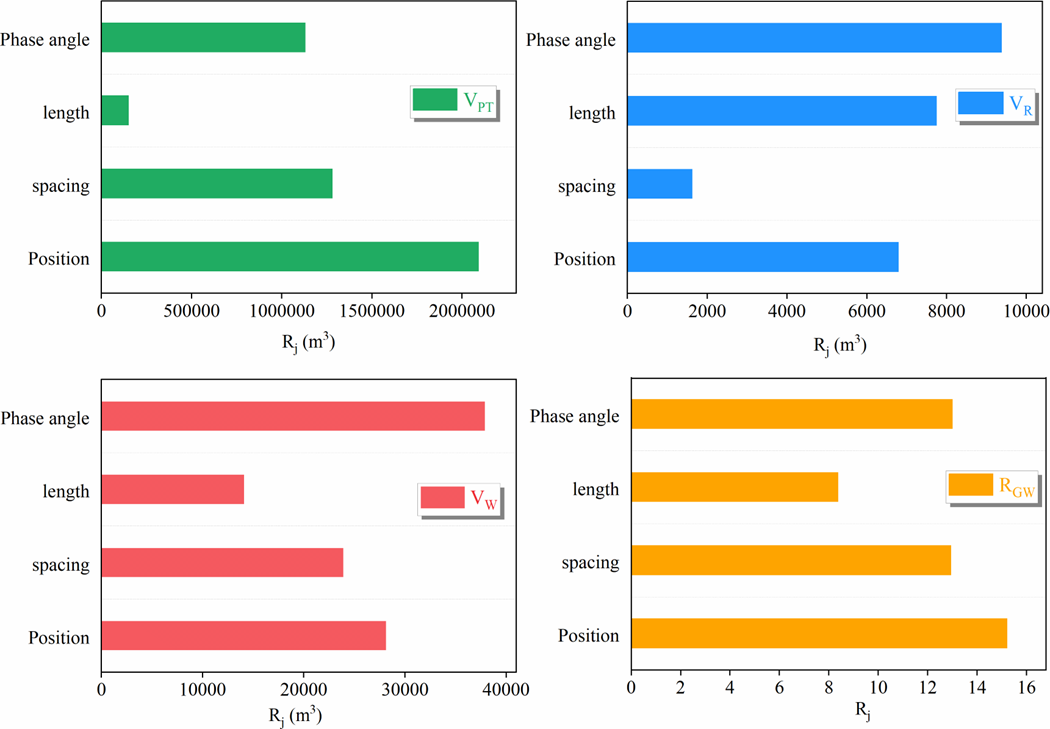
(a) two-branch well

(b) four-branch well
Fig. 4 Comparison of Orthogonal Simulation Test Results of Two-lateral and Four-lateral Wells
(3) Comparison of stimulation effects among different lateral wells
Figure.5 compares the production enhancement effects of single-branch wells, double-branch wells and four-branch wells compared with vertical wells, and the evaluation indicators include average daily gas production, daily water production, gas-water production ratio and specific production index. After comprehensive analysis, the double-branch horizontal well with a specific structure has the best stimulation effect. Key evaluation indicators can be increased by 123% and 81%, respectively. Therefore, it is recommended to use the double-branch well scheme instead of the spiral four-branch well scheme when depressurizing the silty low-permeability hydrate reservoirs in the South China Sea. In addition, cloud image analysis shows that this may be related to the synergistic depressurization effect between the two horizontal lateral wells (Fig. 6a), and this effect will increase with the increase in the number of lateral wells. At the same time, it is found that there is obvious interwell interference between the four-branch horizontal wells (Fig. 6b), and the closer to the intersection of the branch wells, the stronger the interference between the branches.
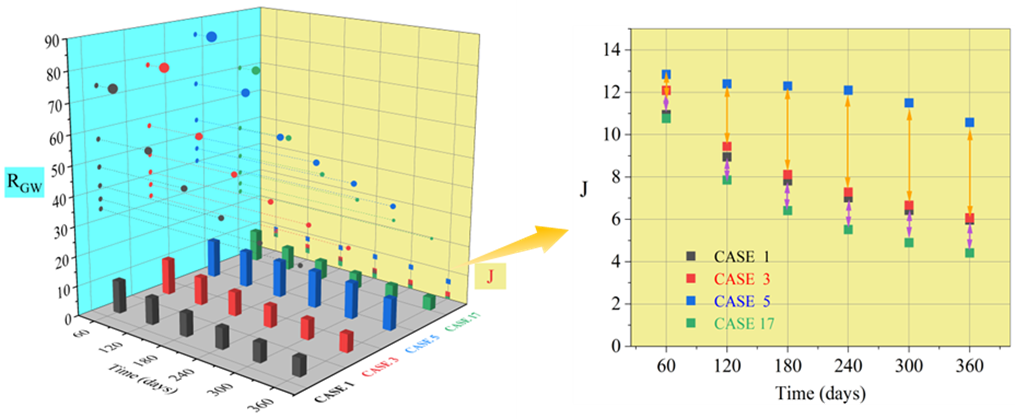

Fig. 5 Comparison of stimulation effects of different multilateral wells
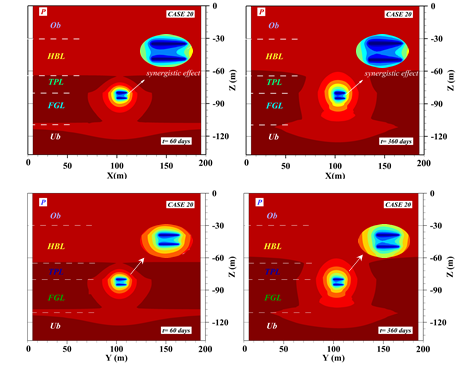
(a) Well interference
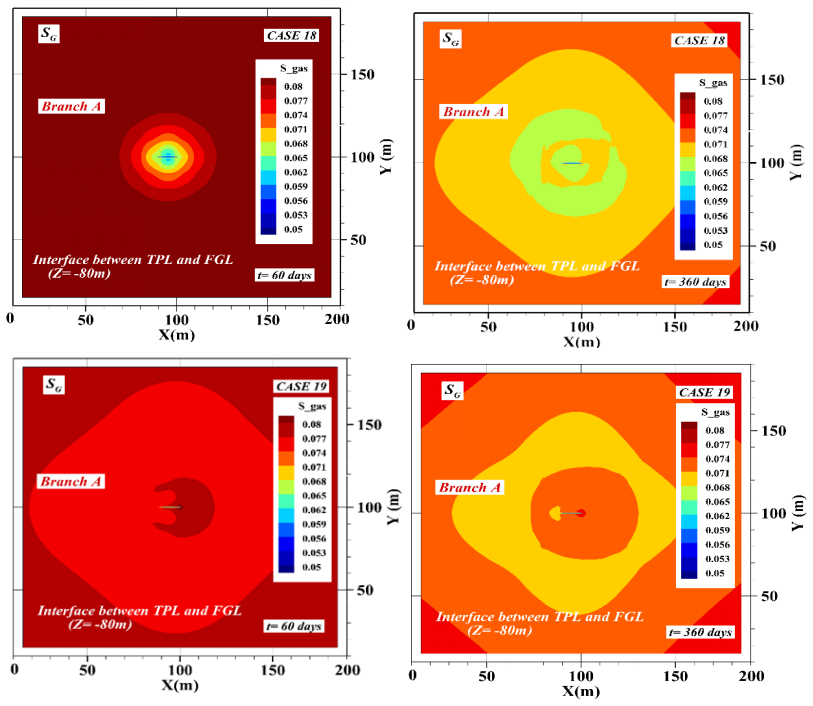
(b) Synergistic pressure reduction
Fig. 6 Collaboration between wells in multilateral wells to reduce pressure and interference effects between wells
4、Conclusions
Based on the available data from the first offshore field test in the Shenhu area, the production performance of different configurations for multilateral horizontal wells is systematically investigated, and the following conclusions can be drawn.
In this paper, through orthogonal simulation tests, the depressurization production potential of multilateral wells under different geometric layout parameters is systematically studied. The main conclusions and understandings are as follows:
① The short-term mining results of the first test mining site in the South China Sea were verified, and the reliability of the three-dimensional heterogeneous heat flow coupling prediction model was verified.
② When considering the vertical well + single branch well deployment scheme, the production well performance of the production well is the best when the branch well is arranged at the interface between the three-phase layer and the free gas layer, which can realize the efficient combined production of the two gases.
③ When considering the vertical well + branch well deployment scheme, the layout location is the main factor affecting the hydrate production efficiency. For four-branch wells (spiral), vertical depth of branch well layout is the main controlling factor.
④ Compared with single vertical well production, the vertical well + two branch wells have the best production increase effect in the short and long term, and the average daily gas production and specific production index can be increased by 123% and 81% respectively.
⑤ The synergistic depressurization formed between branch wells can significantly expand the pressure drop transfer area and promote the decomposition of hydrates, thereby enhancing gas recovery.
⑥ Interference between branch wells will hinder the smooth flow of gas to the wellbore. The closer to the intersection of branch wells, the stronger the interference between branch wells.
Article Source: https://doi.org/10.1016/j.energy.2023.126690